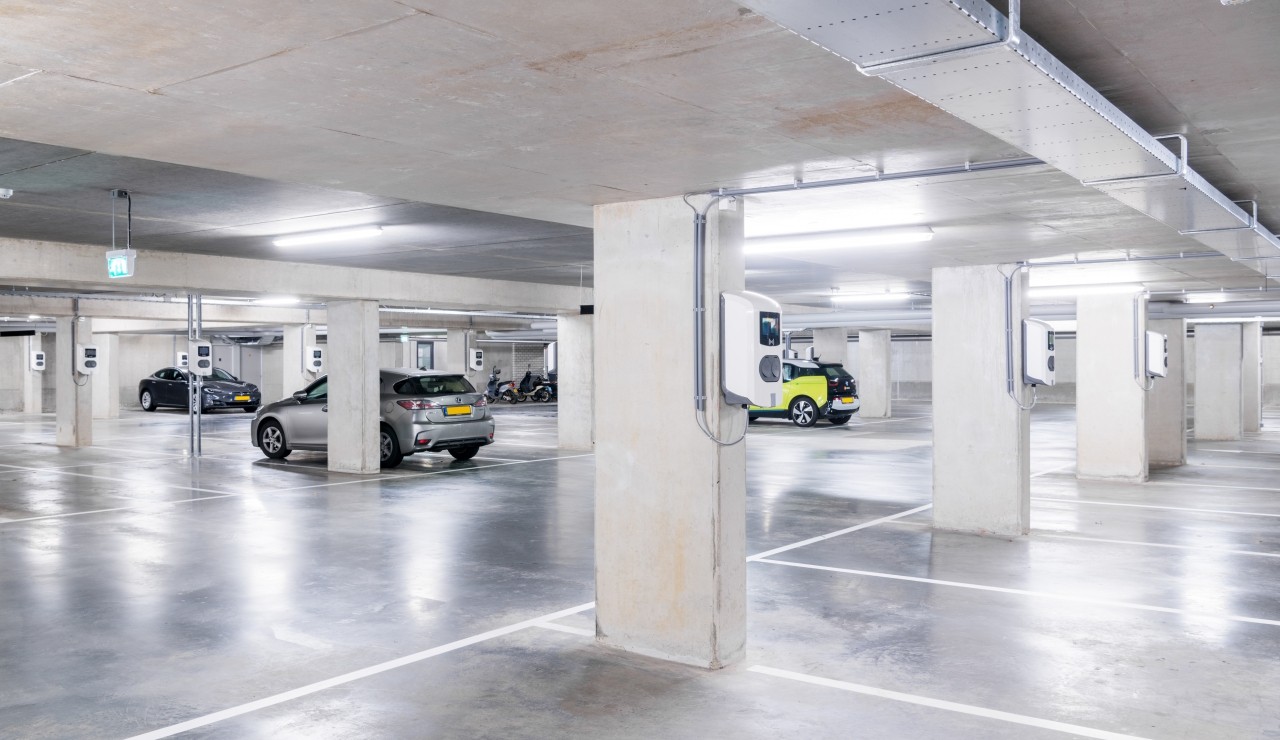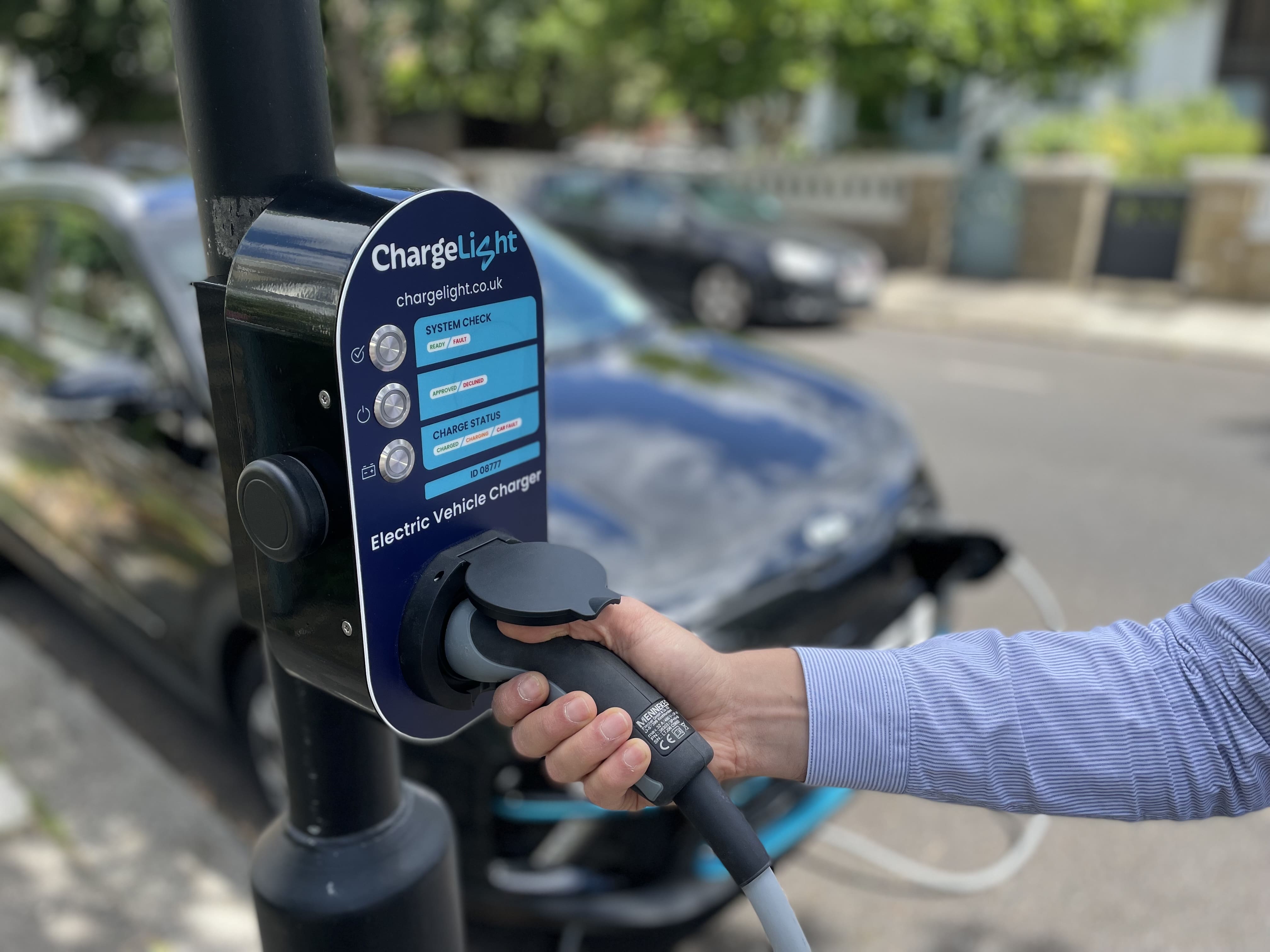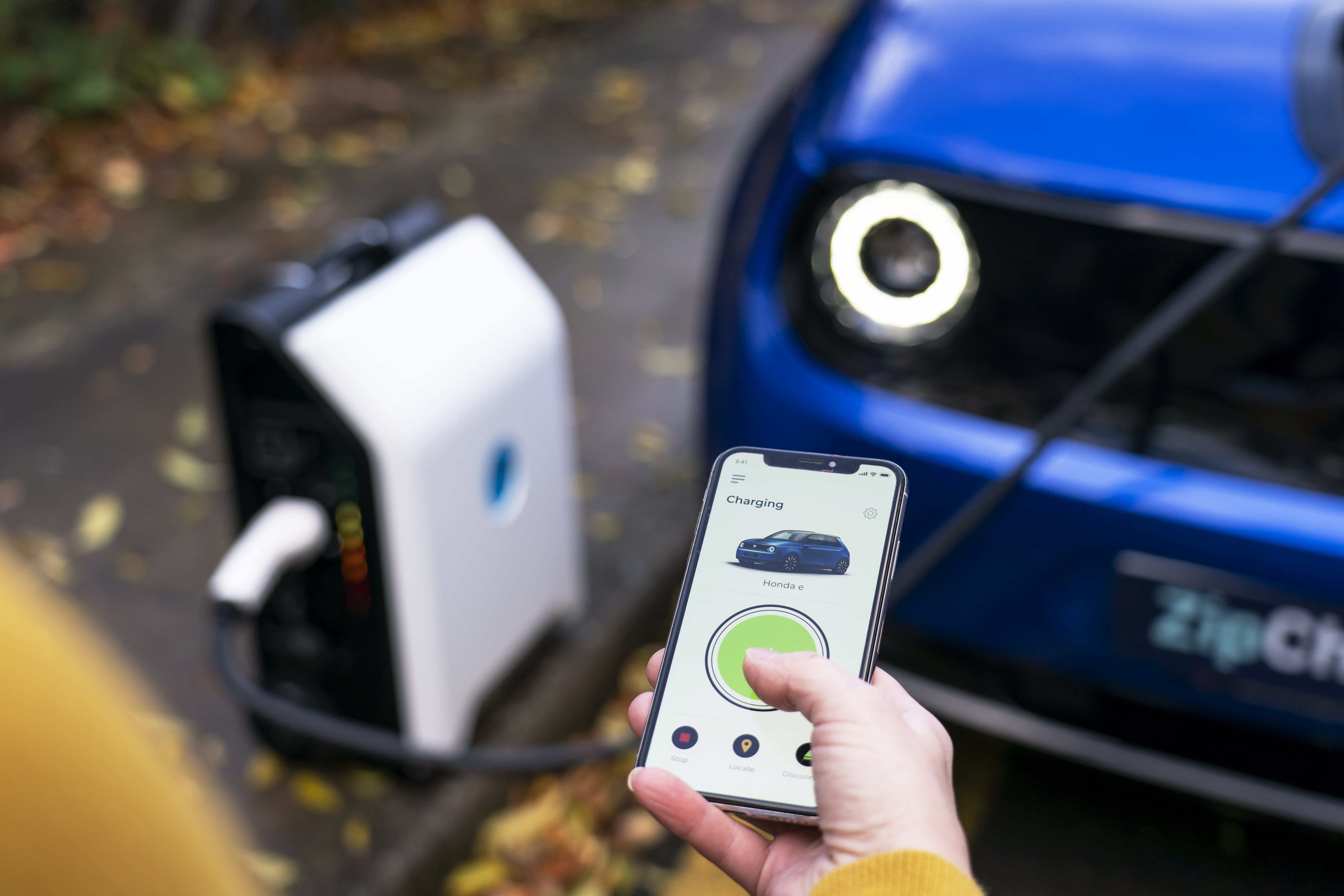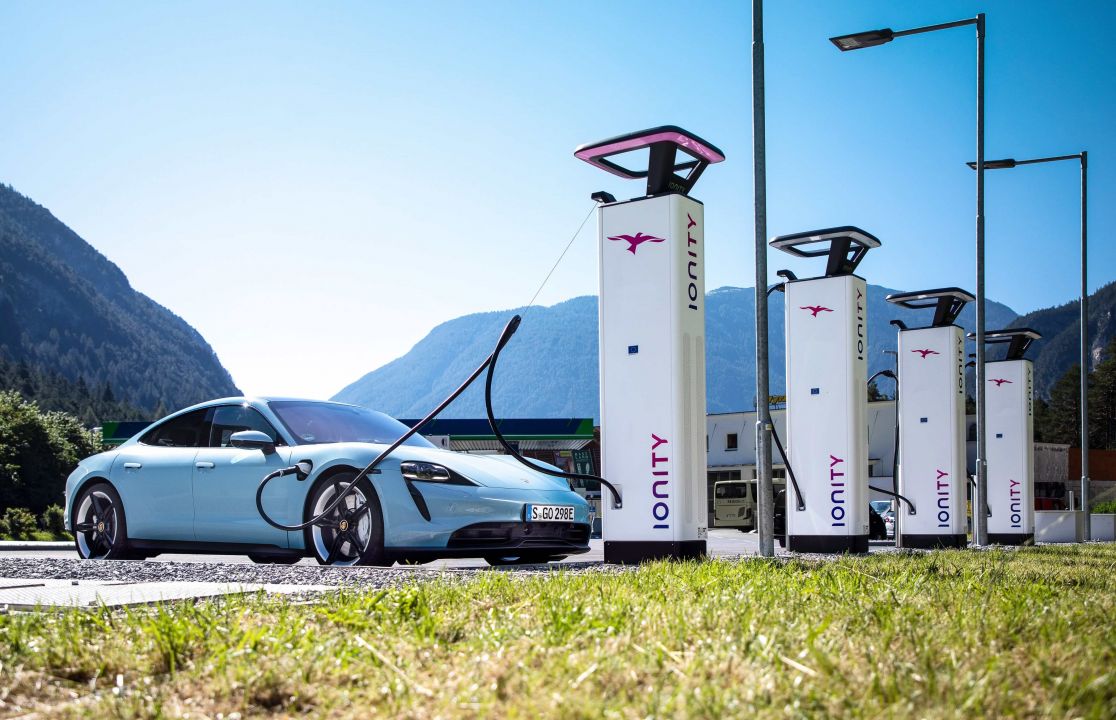-
Dedicated chargers for apartment block residents:
-
- Perhaps one of the trickiest scenarios for EV home charging would be if you lived in a residential apartment block, where cars are normally kept in an underground carpark overnight (or a corresponding multistorey). It would be both inconvenient and impractical to run a charging cable from an apartment to the carpark, so you’d need to find another way around this issue.
-
- Luckily, EVs have brought with them the emergence of dedicated companies that fund, manage and own an entire installation for apartment blocks, which are normally paid for over several years with the usage revenue that they accumulate.
-
- Electric Village is one example of a company that offers such installations. It offers 7.4kW chargers that can add up to 30 miles of range per hour, and considering that most people charge their cars overnight, this should be more than enough for the electric cars on the market today. Once an apartment complex’s landlord provides rights to Electric Village to revamp a parking lot with its charging points, it will usually install its equipment in 100 percent of the spaces, so everyone will have access to a charger if/when they purchase an EV.
-
- If a resident toggles the option to subscribe to one of the chargers, they can essentially “rent” it for a fee of £35.99 per month on a 12-month plan, or £30.99 per month on a 24-month plan, and manage their usage using an associated smartphone app. However, this monthly price does not include electricity usage, making it a potentially expensive option. With Electric Village, there are no costs incurred by either the landlord or the resident until a resident decides to take out a subscription for one of Electric Village’s chargers.

Electric Village's chargers for apartment complexes
-
- Bumblebee is another provider that supplies charging infrastructure for general homes, business’ and workplaces, and also for those that live in apartments. Its turn-key solution incorporates scalable charging infrastructure with 24/7 monitoring, and what it claims to be an “industry leading call out and maintenance service”.
-
- The overall cost will be variable on a case by case basis, but we do know that the charger which will be installed is a product from Easee - namely, the One. It’s a OZEV approved 7kW unit with built-in earthing protection, and is fitted from £989 or £28p/m. Though, this price could be subject to change once Bumblebee gets a better understanding of your requirements and the location where the charger will need to be installed.

Bumblebee's alternative
-
Lamp post chargers:
-
- Maximising space and utilising existing infrastructure will be an integral part of transitioning into the electric era, and fitting charge points on public lamp posts is a great way of doing just that. According to the Shropshire Council, there are an estimated 6.5 million street lights in the UK - and if even a small percentage of those can be converted into lamp post chargers, the nation could be in a significantly better position where EV charging is concerned.
-
- ChargeLight is one such company that’s converting lamp posts into EV charging docks. You can even use ChargeLight’s request form to petition to your local council to request a lamp post EV charging dock installation. You pay a 20p connection fee each time you connect to one of its chargers, with the current rate (subject to change) set at 30p per kWh. The chargers provide 5kW of power, and can range between 3-6kW. Using a common 64kWh battery for reference (like the one found on a Hyundai Kona) and assuming it’s 50 percent full, ChargeLight says it would take just over six hours to fill it up. ChargeLight says Apple and Android apps are also on the way to help make the charging process easier for you.

The lamp-post charging solution from ChargeLight
- Ubitricity is another company that is reinventing lamp posts as EV chargers, and with over 5,500 of its own public points installed in the UK at the time of writing, it claims to be “the largest public charging network in the country”. It’s a member of the Shell group, and also operates outside of the UK in countries like France and Germany.
-
- Installing lamp post chargers at scale will no doubt go a long way towards alleviating the current infrastructural issues we face, and it’s a solution which doesn’t severely disrupt pre-existing architecture or require construction work on the pavement or road

One of over 5,500 chargers implemented by Ubitricity
-
Portable chargers:
-
- Portable EV chargers are another development which almost seemed destined to become part of the solution, given that we have portable chargers for other electrical items like mobile phones. The idea is simple: you purchase a mobile charging unit, which is charged up at home when not in use, and is then transported around in your vehicle to be deployed when your battery begins to run low.
-
- In 2023, UK-based start-up ZipCharge will also make its introduction into the market with its ‘Go’ portable charger. The first iteration will provide 4kW of power, with 6 and 8kW models also planned for the future. ZipCharge has previously calculated that the Go can add between 20-40 miles of range to a common electric car in between 30-60 minutes, and provides a comparable speed to that of a 7.2kW home wallbox. Better still, it will be a similar shape and size to a wheeled hand-luggage suitcase that people commonly use for holidays, making it a fair amount smaller than the aforementioned Kempower T-Series.

A Honda e using ZipCharge's portable charger
-
-
Charge delivery:
-
- Charge delivery is where a company will send out a vehicle housing a mobile charging unit to your location, topping up your car’s battery reserves as required. An example of a charge delivery provider is Charge Fairy, who can also remotely monitor the battery level on your car before sending out an all-electric van to recharge your EV. The app - which is used to track information about your vehicle usage and next predicted recharge - is currently compatible with those of 11 car manufacturers including Audi, Peugeot and Mercedes-Benz.
-
- Once Charge Fairy sends a vehicle out, it will then arrive at your location and either park in front/behind your car, or in the event that this is not possible, attach an extended cable from the nearest possible parking spot of up to 15 metres (or three cars) away. Charge Fairy’s packages start from £5.99 per week, which gets you 50kWh of charge per week (150-200 miles estimated), as well as on-location charging (they will come to you). No pre-booking is required, either.

A Nissan e-NV200 deployed by Charge Fairy to a customer in need of range
-
-
Peer-to-peer charging:
-
- Peer-to-peer charging is a system created to allow shared usage of chargers. This is split into two categories: the host and the user. The host is the person that already owns the charge point, and will provide use of their charger for a small fee. The user is the person who will be paying the host for usage.
-
- This exchange has many benefits to it. From the host’s perspective, they are gaining an income, allowing them to recoup some of the funds originally invested in buying the charger, in addition to contributing towards offsetting their own energy usage. For the user, it presents a low cost solution for access to a range of charge points around their neighbourhood and local community for a small fee.
-
- But as is the case with any ‘shared’ multi-user service, there are some things to consider, particularly for the host. The first is potential damage to the charger. Different people will be using this charger, and it’s not always guaranteed that some will be as careful with it as others will be. This could lead to charger damage sooner than expected, and provide the host with an unwanted repair bill.
-
- The second consideration for hosts is that they will be dealing with strangers and unfamiliar people, since it may not always be neighbours and friends/family that pay to use their charger. Sadly, this could present a potential safety risk and security issue, to and from both hosts and users
-
- To try and limit this risk to their hosts (and users), Co-Charger tries to facilitate “regular, ongoing arrangements between the same people week in, week out”. The host’s will also always be required to be verified to ensure safety and security for users.
-
- In instances of theft or damage when a charging session is conducted, Co-Charger says issues could be covered by either your car insurance provider (for users) or home insurance provider (for hosts), and advises both parties to check the terms with their respective insurance providers before engaging.

-
-
Charging location apps:
-
-
- To make finding chargers nearby to your location easier, be it at home or out on the road, there are multiple smartphone apps, such as Bonnet, that can be used to both access and pay for electric car charging at public charge points.
-
- Based in London, Bonnet provided access to thousands of charge points around Britain and parts of Europe. Using its app, you can make use of around 3,700 chargers in the UK, in addition to over 13,800 in Holland, 6,900 in Germany and 4,300 in Belgium, among others. In terms of pricing, Bonnet calculates its amount respective of the pay as you go price set by the given charge point’s network operator. If you subscribe, you pay a monthly subscription fee to then get a percentage of the cost off each time you use a charger.
-
- The real draw of Bonnet is its offer of bringing the ability to pay for multiple charge point providers together in one app, meaning you don’t need separate accounts and access cards for each individual electric car charging company. Essentially, it can be seen as an inclusive hub for a variety of providers, making it easier to find and pay for a charger regardless of your location.
 Bonnet's app gives access to around 3,700 charge points in the UK
Bonnet's app gives access to around 3,700 charge points in the UK
-
- Another example of these charging location apps is Zap-Map. Its app claims to connect 95 percent of charge points currently mapped, with around 70 percent of those showing live availability when the app is accessed. It claims to be “the UK’s leading app and digital platform for EV drivers to search for available charge points, plan longer electric journeys, pay for charging and share updates with other EV drivers”.
-
- Zap-Map uses an in-app based paying system called Zap-Pay, which is linked to your credit or debit card. It works on a pay as you go basis, with rates set to a similar amount to that of the charging networks’ standard given price - with a small transaction fee chargeable per session completed.
 Zap-Map claims its app can connect to 95 percent of the charge points it displays
Zap-Map claims its app can connect to 95 percent of the charge points it displays

